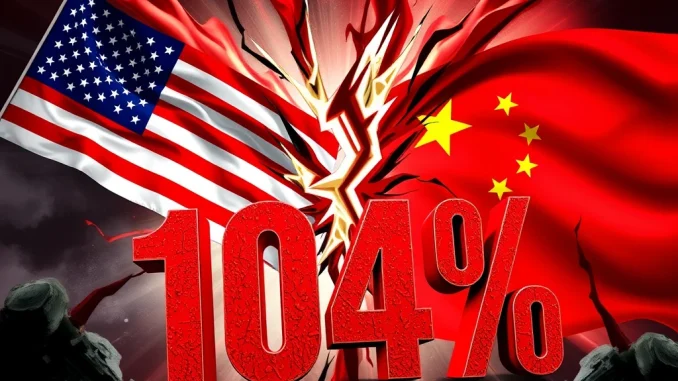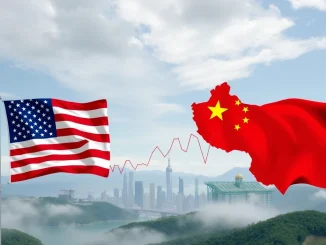
Buckle up, folks, because the economic landscape just shifted dramatically! In a move that’s sending ripples across global markets, the White House has confirmed the implementation of a staggering 104% tariff on Chinese goods. This isn’t just a minor adjustment; it’s a seismic escalation in the ongoing US-China trade tensions, and it’s happening right now. Let’s dive into what this means for you, the markets, and the future of international trade.
What Sparked This Massive Tariff Hike on Chinese Goods?
According to a report from Walter Bloomberg, citing Fox Business on X (formerly Twitter), the White House Press Secretary made the announcement that this hefty tariff took effect at noon ET. The catalyst? China’s failure to withdraw its retaliatory measures. Essentially, this is a tit-for-tat escalation, a trade war intensifying before our very eyes. The tariffs will officially begin being collected on April 9th, marking the date when businesses and consumers will start feeling the pinch directly.
To break it down simply:
- Retaliation Trigger: The US states China didn’t back down on its retaliatory measures.
- Massive Hike: A 104% tariff is not just significant; it’s a punitive measure designed to exert maximum pressure.
- Immediate Effect: The tariff is already in effect as of noon ET.
- Collection Date: Tariffs will be collected starting April 9th.
The Global Economy Braces for Impact: Understanding the Trade War Fallout
A trade war, especially between the world’s two largest economies, is never isolated. It’s a complex web of interconnected consequences that can impact everyone, from multinational corporations to your local grocery store. Here’s a glimpse at the potential ripple effects on the global economy:
- Supply Chain Disruptions: Expect potential disruptions to supply chains. Many industries rely on components and goods from China. Increased tariffs can lead to companies rethinking their sourcing strategies, potentially leading to delays and increased costs.
- Inflationary Pressures: Higher tariffs often translate to higher prices for consumers. Companies may pass on these increased costs, contributing to inflationary pressures across various sectors. This could impact the purchasing power of individuals and households globally.
- Market Volatility: Uncertainty is the enemy of markets. Trade wars inject significant uncertainty, which can lead to increased volatility in stock markets, currency exchange rates, and commodity prices. Investors tend to become risk-averse during such times.
- Slower Economic Growth: Trade barriers can stifle economic growth. Reduced trade volumes, increased costs, and business uncertainty can collectively slow down economic activity both in the US, China, and globally.
- Geopolitical Tensions: Trade disputes often spill over into other areas of international relations, potentially exacerbating geopolitical tensions and creating a less stable global environment.

How Will These Tariffs on Chinese Goods Affect You Directly?
You might be wondering, “Okay, global economy stuff is important, but how does this actually affect me?” The impact can be more direct than you think:
- Higher Prices for Consumer Goods: Many everyday products, from electronics and clothing to household items, are either made in China or contain Chinese components. Tariffs increase the cost of importing these goods, which could lead to price hikes at your favorite stores.
- Impact on Businesses: Businesses that import from China will face higher costs. This could lead to reduced profits, potential job cuts, or, again, passing on the costs to consumers through price increases. Small and medium-sized businesses might be particularly vulnerable.
- Investment Implications: For investors, including those in the cryptocurrency space, these tariffs introduce new layers of risk and uncertainty. Market volatility could increase, and investment strategies may need to be re-evaluated in light of these shifting economic dynamics.
- Potential for Retaliation (Again): Trade wars are rarely one-sided. China is likely to respond with further retaliatory measures, potentially targeting US exports. This cycle of escalation can prolong the economic pain and uncertainty.
Navigating the Trade War: Challenges and Potential Opportunities
While trade wars are inherently disruptive, they also present both challenges and, perhaps surprisingly, some opportunities:
| Challenges | Potential Opportunities |
|---|---|
| Increased costs for businesses and consumers | Companies may diversify supply chains away from China, creating opportunities for other nations. |
| Market volatility and economic uncertainty | Some domestic industries in the US might see a boost due to reduced competition from Chinese imports. |
| Potential for reduced global trade and slower economic growth | Innovation and efficiency may be spurred as businesses seek to adapt to the new trade environment. |
| Geopolitical tensions and strained international relations | Could push for stronger regional trade partnerships outside of the US-China sphere of influence. |
The Future of US-China Trade and the Shadow of Tariffs
This 104% tariff is a significant escalation, but it’s likely not the final chapter. The US-China trade relationship is complex and multifaceted, and this move signals a period of heightened tension and uncertainty. Whether this is a negotiating tactic, a long-term shift in trade policy, or something else entirely remains to be seen.
For those in the cryptocurrency and broader financial markets, staying informed and adaptable is crucial. Trade wars can create both risks and opportunities, and understanding the evolving dynamics is key to navigating this complex landscape. Keep an eye on further developments, as this story is far from over.
In Conclusion: A Trade Earthquake Shakes the Global Economy
The White House’s confirmation of a 104% tariff on Chinese goods is a powerful tremor in the global economic order. It’s a stark reminder of the fragility of international trade relations and the potential for rapid, impactful shifts. As we move forward, businesses, consumers, and investors alike will need to carefully assess the implications of this escalating trade war and prepare for a potentially volatile economic future. The ramifications of these tariffs on Chinese goods are only just beginning to unfold, and the world is watching closely.



